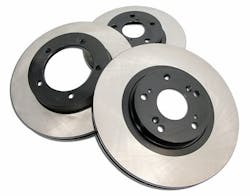The federal government had an opportunity to mandate three types of automatic emergency braking (AEB) technologies on all light vehicles last year. But in January 2017, the National Highway Traffic Safety Administration (NHTSA) said no. The agency explained AEB technologies are already here, and its own rule making process would delay the development of even better technologies for improving vehicle safety.
NHTSA denied a petition from Consumer Watchdog, Center for Auto Safety, and Public Citizen. The groups had asked NHTSA to mandate forward crash warning (FCW), crash imminent braking (CIB), and dynamic brake support (DBS) in light vehicles. The agency explained why in the Jan. 25 edition of the Federal Register.
NHTSA noted that many modern vehicle safety technologies are relatively new and evolving quickly. “Standard setting at this early stage of technological evolution must be undertaken with great care, given the risk of inadvertently stymieing innovation and stalling the development and introduction of successively better versi ons of these technologies.”
AEB is already in the marketplace. The agency attributed an upturn in the rate of AEB installation to the rating programs of the Insurance Institute for Highway Safety, Consumer Reports, and its own New Car Assessment Program.
NHTSA also pointed out that 20 vehicle manufacturers representing more than 99% of all light motor vehicle sales in the U.S. made a voluntary commitment to installing FCW and CIB technologies in March 2016. These manufacturers have promised to make FCW and CIB standard on virtually all light cars and trucks with a gross vehicle weight of 8,500 lbs. or less by Sept. 2, 2022. FCW and CIB will be standard on trucks with a gross vehicle weight between 8,501 lbs. and 10,000 lbs. by Sept. 1, 2025.
Reliable components needed
AEB depends on reliable brake components as well as technology. Almost every aspect of the new safety technology is directed to the brake system, according to Wally Marciniak, technical trainer at Brake Parts Inc. LLC, manufacturer of Raybestos brand brakes.
“Through electronics, the brake system can apply 15 to 20 times per second without input from the driver. With that said, the integrity of brake components such as calipers, brake pads, master cylinder, rotors and drums must be up to the task to be able to control the direction and stopping ability of the vehicle.”Steve Ruiz, vice president of engineering of CWD LLC, which does business as Centric Parts, notes the only change with these new systems is that the brakes are applied automatically if the driver fails to stop on time. “Whether it is the driver or the computer-controlled on-board systems doing the braking, brake system components need to be engineered and manufactured to a very high standard to perform as expected when they are needed. Therefore, these new automated braking technologies will not have a significant impact on well-made brake system components. The extra demands will really be placed on maintaining the system and its components to ensure that they are functioning properly.”
Diagnosis is more than a code
In the “old days” a driver would bring a car to a shop complaining of a squeal or a pull to the side when the brakes were applied. A sensor now alerts a driver to a malfunction. But diagnosis involves more than reading a code.
A technician should start with a road test to duplicate the customer’s concern, followed by a visual inspection, according to Marciniak. “Additionally, the technician should also connect a scan tool to see if any failure codes are present. In many cases, a sensor that is out of specs can cause the brake system to react in different ways and lead to problems such as brake pulls, premature wear and brake drag of one wheel.”
Ruiz says that even though the onboard diagnostic capabilities of automobiles have increased tremendously and will continue to improve over the coming years, technicians will still need to thoroughly inspect for all possible malfunctions.
“As automated and self-driving technologies become more prevalent, most of the driver feedback will be removed from the equation for the most part, so technicians will need to know what to look for when analyzing data and inspecting parts. In fact, technicians will likely have to be specifically trained and qualified to work using the new system’s analytical tools and inspection procedures.” ■
About the Author

Ann Neal
Ann Neal is a former senior editor at Modern Tire Dealer.
